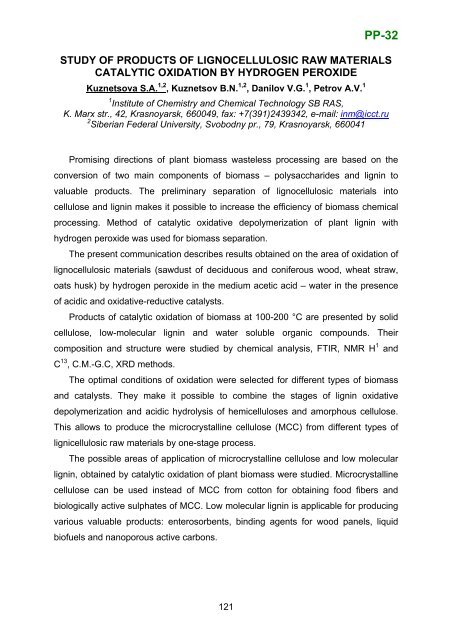Boreskov Institute of Catalysis SB RAS, Novosibirsk, Russia
Boreskov Institute of Catalysis SB RAS, Novosibirsk, Russia
Boreskov Institute of Catalysis SB RAS, Novosibirsk, Russia
- No tags were found...
Create successful ePaper yourself
Turn your PDF publications into a flip-book with our unique Google optimized e-Paper software.
PP-32STUDY OF PRODUCTS OF LIGNOCELLULOSIC RAW MATERIALSCATALYTIC OXIDATION BY HYDROGEN PEROXIDEKuznetsova S.A. 1,2 , Kuznetsov B.N. 1,2 , Danilov V.G. 1 , Petrov A.V. 11 <strong>Institute</strong> <strong>of</strong> Chemistry and Chemical Technology <strong>SB</strong> <strong>RAS</strong>,K. Marx str., 42, Krasnoyarsk, 660049, fax: +7(391)2439342, e-mail: inm@icct.ru2 Siberian Federal University, Svobodny pr., 79, Krasnoyarsk, 660041Promising directions <strong>of</strong> plant biomass wasteless processing are based on theconversion <strong>of</strong> two main components <strong>of</strong> biomass – polysaccharides and lignin tovaluable products. The preliminary separation <strong>of</strong> lignocellulosic materials intocellulose and lignin makes it possible to increase the efficiency <strong>of</strong> biomass chemicalprocessing. Method <strong>of</strong> catalytic oxidative depolymerization <strong>of</strong> plant lignin withhydrogen peroxide was used for biomass separation.The present communication describes results obtained on the area <strong>of</strong> oxidation <strong>of</strong>lignocellulosic materials (sawdust <strong>of</strong> deciduous and coniferous wood, wheat straw,oats husk) by hydrogen peroxide in the medium acetic acid – water in the presence<strong>of</strong> acidic and oxidative-reductive catalysts.Products <strong>of</strong> catalytic oxidation <strong>of</strong> biomass at 100-200 °C are presented by solidcellulose, low-molecular lignin and water soluble organic compounds. Theircomposition and structure were studied by chemical analysis, FTIR, NMR H 1 andC 13 , C.M.-G.C, XRD methods.The optimal conditions <strong>of</strong> oxidation were selected for different types <strong>of</strong> biomassand catalysts. They make it possible to combine the stages <strong>of</strong> lignin oxidativedepolymerization and acidic hydrolysis <strong>of</strong> hemicelluloses and amorphous cellulose.This allows to produce the microcrystalline cellulose (MCC) from different types <strong>of</strong>lignicellulosic raw materials by one-stage process.The possible areas <strong>of</strong> application <strong>of</strong> microcrystalline cellulose and low molecularlignin, obtained by catalytic oxidation <strong>of</strong> plant biomass were studied. Microcrystallinecellulose can be used instead <strong>of</strong> MCC from cotton for obtaining food fibers andbiologically active sulphates <strong>of</strong> MCC. Low molecular lignin is applicable for producingvarious valuable products: enterosorbents, binding agents for wood panels, liquidbi<strong>of</strong>uels and nanoporous active carbons.121
















